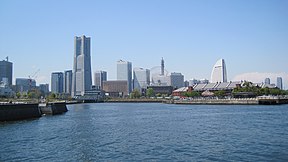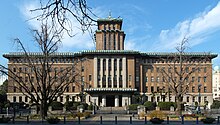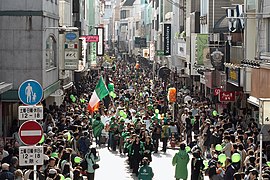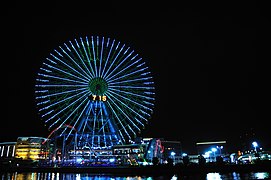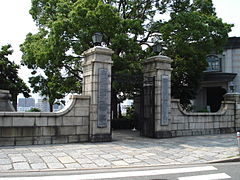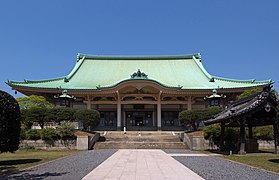Yokohama
Yokohama
横浜市 | |
|---|---|
Designated city | |
| City of Yokohama | |
Clockwise from top: Minato Mirai 21, Nippon Maru Memorial Park, Yokohama Chinatown, Motomachi Shopping Street, Yokohama Marine Tower viewed from Yamashita Park, and Ōsanbashi Pier | |
 Flag  Seal | |
 | |
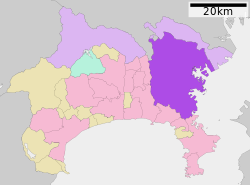 Map of Kanagawa Prefecture with Yokohama highlighted in purple | |
 Yokohama | |
| Coordinates: 35°26′39″N 139°38′17″E / 35.44417°N 139.63806°ECoordinates: 35°26′39″N 139°38′17″E / 35.44417°N 139.63806°E | |
| Country | |
| Region | Kantō |
| Prefecture | Kanagawa Prefecture |
| Government | |
| • Mayor | Fumiko Hayashi |
| Area | |
| • Total | 437.38 km2 (168.87 sq mi) |
| Population (October 1, 2016) | |
| • Total | 3,732,616 |
| • Density | 8,534.03/km2 (22,103.0/sq mi) |
| Time zone | UTC+9 (Japan Standard Time) |
| – Tree | Camellia, Chinquapin, Sangoju Sasanqua, Ginkgo, Zelkova |
| – Flower | Rose |
| Address | 1-1 Minato-chō, Naka-ku, Yokohama-shi, Kanagawa-ken 231-0017 |
| Website | www |
| Yokohama | |||
|---|---|---|---|
"Yokohama" in new-style (shinjitai) kanji | |||
| Japanese name | |||
| Hiragana | よこはま | ||
| Katakana | ヨコハマ | ||
| Kyūjitai | 橫濱 | ||
| Shinjitai | 横浜 | ||
| |||
Yokohama (Japanese: 横浜, pronounced [jokohama] (![]() listen)) is the second-largest city in Japan by population[1] and the most populous municipality of Japan. It is the capital city of Kanagawa Prefecture. It lies on Tokyo Bay, south of Tokyo, in the Kantō region of the main island of Honshu. It is a major commercial hub of the Greater Tokyo Area.
listen)) is the second-largest city in Japan by population[1] and the most populous municipality of Japan. It is the capital city of Kanagawa Prefecture. It lies on Tokyo Bay, south of Tokyo, in the Kantō region of the main island of Honshu. It is a major commercial hub of the Greater Tokyo Area.
Yokohama developed rapidly as Japan's prominent port city following the end of Japan's relative isolation in the mid-19th century and is today one of its major ports along with Kobe, Osaka, Nagoya, Fukuoka, Tokyo and Chiba.
Etymology[]
Yokohama (横浜) means "horizontal beach".[2] The current area surrounded by Maita Park, the Ōoka River and the Nakamura River have been a gulf divided by a sandbar from the open sea. This sandbar was the original Yokohama fishing village. Since the sandbar protruded perpendicularly from the land, or horizontally when viewed from the sea, it was called a "horizontal beach".[3]
History[]
Opening of the Treaty Port (1859–1868)[]
Yokohama was a small fishing village up to the end of the feudal Edo period, when Japan held a policy of national seclusion, having little contact with foreigners.[4] A major turning point in Japanese history happened in 1853–54, when Commodore Matthew Perry arrived just south of Yokohama with a fleet of American warships, demanding that Japan open several ports for commerce, and the Tokugawa shogunate agreed by signing the Treaty of Peace and Amity.[5]
It was initially agreed that one of the ports to be opened to foreign ships would be the bustling town of Kanagawa-juku (in what is now Kanagawa Ward) on the Tōkaidō, a strategic highway that linked Edo to Kyoto and Osaka. However, the Tokugawa shogunate decided that Kanagawa-juku was too close to the Tōkaidō for comfort, and port facilities were instead built across the inlet in the sleepy fishing village of Yokohama. The Port of Yokohama was officially opened on June 2, 1859.[6]
Yokohama quickly became the base of foreign trade in Japan. Foreigners initially occupied the low-lying district of the city called Kannai, residential districts later expanding as the settlement grew to incorporate much of the elevated Yamate district overlooking the city, commonly referred to by English speaking residents as The Bluff.
Kannai, the foreign trade and commercial district (literally, inside the barrier), was surrounded by a moat, foreign residents enjoying extraterritorial status both within and outside the compound. Interactions with the local population, particularly young samurai, outside the settlement inevitably caused problems; the Namamugi Incident, one of the events that preceded the downfall of the shogunate, took place in what is now Tsurumi Ward in 1862, and prompted the Bombardment of Kagoshima in 1863.
To protect British commercial and diplomatic interests in Yokohama a military garrison was established in 1862. With the growth in trade increasing numbers of Chinese also came to settle in the city.[7] Yokohama was the scene of many notable firsts for Japan including the growing acceptance of western fashion, photography by pioneers such as Felice Beato, Japan's first English language newspaper, the published in 1861 and in 1865 the first ice cream and beer to be produced in Japan.[8] Recreational sports introduced to Japan by foreign residents in Yokohama included European style horse racing in 1862, cricket in 1863[9] and rugby union in 1866. A great fire destroyed much of the foreign settlement on November 26, 1866, and smallpox was a recurrent public health hazard, but the city continued to grow rapidly – attracting foreigners and Japanese alike.
- Gallery
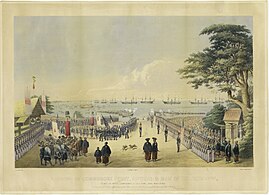
Landing of Commodore Perry and men to meet the Imperial commissioners at Yokohama, 14 July 1853.

Foreign ships in Yokohama harbor
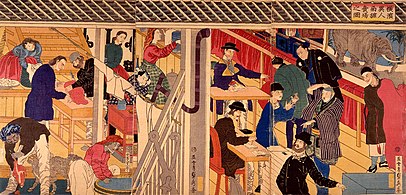
A foreign trading house in Yokohama in 1861
Meiji and Taisho Periods (1868–1923)[]
After the Meiji Restoration of 1868, the port was developed for trading silk, the main trading partner being Great Britain. Western influence and technological transfer contributed to the establishment of Japan's first daily newspaper (1870), first gas-powered street lamps (1872) and Japan's first railway constructed in the same year to connect Yokohama to Shinagawa and Shinbashi in Tokyo. In 1872 Jules Verne portrayed Yokohama, which he had never visited, in an episode of his widely read novel Around the World in Eighty Days, capturing the atmosphere of the fast-developing, internationally oriented Japanese city.
In 1887, a British merchant, Samuel Cocking, built the city's first power plant. At first for his own use, this coal-burning plant became the basis for the Yokohama Cooperative Electric Light Company. The city was officially incorporated on April 1, 1889.[10] By the time the extraterritoriality of foreigner areas was abolished in 1899, Yokohama was the most international city in Japan, with foreigner areas stretching from Kannai to the Bluff area and the large Yokohama Chinatown.
The early 20th century was marked by rapid growth of industry. Entrepreneurs built factories along reclaimed land to the north of the city toward Kawasaki, which eventually grew to be the Keihin Industrial Area. The growth of Japanese industry brought affluence, and many wealthy trading families constructed sprawling residences there, while the rapid influx of population from Japan and Korea also led to the formation of Kojiki-Yato, then the largest slum in Japan.
- Gallery
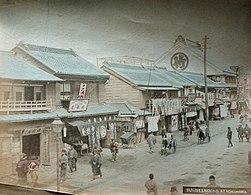
Street scene c. 1880.

Yokohama c. 1880
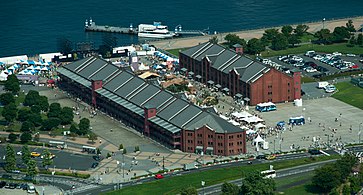
Yokohama Red Brick Warehouse was built in 1913
Great Kanto earthquake and the Second World War (1923–1945)[]
- Gallery

Future Emperor Hirohito viewing Yokohama immediately after the Great Kanto Earthquake in 1923

View of Yokohama after the bombing in 1945
Much of Yokohama was destroyed on September 1, 1923, by the Great Kantō earthquake. The Yokohama police reported casualties at 30,771 dead and 47,908 injured, out of a pre-earthquake population of 434,170.[11] Fuelled by rumors of rebellion and sabotage, vigilante mobs thereupon murdered many Koreans in the Kojiki-yato slum.[12] Many people believed that Koreans used black magic to cause the earthquake. Martial law was in place until November 19. Rubble from the quake was used to reclaim land for parks, the most famous being the Yamashita Park on the waterfront which opened in 1930.
Yokohama was rebuilt, only to be destroyed again by U.S. air raids during World War II. An estimated seven or eight thousand people were killed in a single morning on May 29, 1945, in what is now known as the Great Yokohama Air Raid, when B-29s firebombed the city and in just one hour and nine minutes reduced 42% of it to rubble.[10]
Post-World War II growth[]
During the American occupation, Yokohama was a major transshipment base for American supplies and personnel, especially during the Korean War. After the occupation, most local U.S. naval activity moved from Yokohama to an American base in nearby Yokosuka.
The city was designated by government ordinance on September 1, 1956.[citation needed] The city's tram and trolleybus system was abolished in 1972, the same year as the opening of the first line of Yokohama Municipal Subway. Construction of Minato Mirai 21 ("Port Future 21"), a major urban development project on reclaimed land, started in 1983. Minato Mirai 21 hosted the Yokohama Exotic Showcase in 1989, which saw the first public operation of maglev trains in Japan and the opening of Cosmo Clock 21, then the tallest Ferris wheel in the world. The 860m-long Yokohama Bay Bridge opened in the same year. In 1993, Minato Mirai saw the opening of the Yokohama Landmark Tower, the second tallest building in Japan.
The 2002 FIFA World Cup final was held in June at the International Stadium Yokohama. In 2009, the city marked the 150th anniversary of the opening of the port and the 120th anniversary of the commencement of the City Administration. An early part in the commemoration project incorporated the Fourth Tokyo International Conference on African Development (TICAD IV) which was held in Yokohama in May 2008. In November 2010, Yokohama hosted the Asia-Pacific Economic Cooperation (APEC) meeting.
- Gallery

In 1951, during the Korean War, this United States Navy ship departed Yokohama, carrying war dead to the U.S.
Yokohama Landmark Tower (1993)

Minato Mirai 21 at dusk
Geography[]
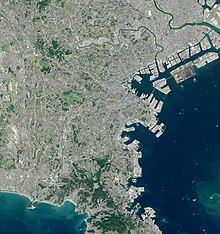
Topography[]
Yokohama has a total area of 437.38 km2 and is located 5 meters above sea level. It is the capital of Kanagawa prefecture, bordered to the east by Tokyo Bay and located in the middle of the Kantō plain. The city is surrounded by hills and the characteristic mountain system of the island of Honshū, so its growth has been limited and it has had to gain ground from the sea. This also affects the population density, one of the highest in Japan with 8,500 inhabitants per km2.
The highest points within the urban boundary are Omaruyama (156 m) and Mount Enkaizan (153 m). The main river is the Tsurumi River, which begins in the Tama Hills and empties into the Pacific Ocean.[13]
These municipalities surround Yokohama: Kawasaki, Yokosuka, Zushi, Kamakura, Fujisawa, Yamato, Machida.
Geology[]
The city is very prone to natural phenomena such as earthquakes and tropical cyclones because the island of Honshū has a high seismic activity, being in the middle of the Pacific Ring of Fire.
Most seismic movements are of low intensity and are generally not perceived by people. However, Yokohama has experienced two major tremors that reflect the evolution of Earthquake engineering: the 1923 Great Kantō earthquake devastated the city and caused more than 100,000 fatalities throughout the region,[14] while the 2011 Tōhoku earthquake and tsunami, with its epicenter on the east coast, was felt in the locality but only material damage was lamented because most buildings were already prepared to withstand them.[15]
Climate[]
Yokohama features a humid subtropical climate (Köppen: Cfa) with hot, humid summers and chilly winters.[16] Weatherwise, Yokohama has a pattern of rain, clouds and sun, although in winter, it is surprisingly sunny, more so than Southern Spain. Winter temperatures rarely drop below freezing, while summer can seem quite warm, because of the effects of humidity.[17] The coldest temperature was on 24 January 1927 when −8.2 °C (17.2 °F) was reached, whilst the hottest day was 11 August 2013 at 37.4 °C (99.3 °F). The highest monthly rainfall was in October 2004 with 761.5 millimetres (30.0 in), closely followed by July 1941 with 753.4 millimetres (29.66 in), whilst December and January have recorded no measurable precipitation three times each.
| hideClimate data for Yokohama (1991−2020 normals, extremes 1896−present) | |||||||||||||
|---|---|---|---|---|---|---|---|---|---|---|---|---|---|
| Month | Jan | Feb | Mar | Apr | May | Jun | Jul | Aug | Sep | Oct | Nov | Dec | Year |
| Record high °C (°F) | 20.8 (69.4) |
24.8 (76.6) |
24.5 (76.1) |
28.7 (83.7) |
31.3 (88.3) |
35.5 (95.9) |
37.2 (99.0) |
37.4 (99.3) |
36.2 (97.2) |
32.4 (90.3) |
26.2 (79.2) |
23.7 (74.7) |
37.4 (99.3) |
| Average high °C (°F) | 10.2 (50.4) |
10.8 (51.4) |
14.0 (57.2) |
18.9 (66.0) |
23.1 (73.6) |
25.5 (77.9) |
29.4 (84.9) |
31.0 (87.8) |
27.3 (81.1) |
22.0 (71.6) |
17.1 (62.8) |
12.5 (54.5) |
20.2 (68.4) |
| Daily mean °C (°F) | 6.1 (43.0) |
6.7 (44.1) |
9.7 (49.5) |
14.5 (58.1) |
18.8 (65.8) |
21.8 (71.2) |
25.6 (78.1) |
27.0 (80.6) |
23.7 (74.7) |
18.5 (65.3) |
13.4 (56.1) |
8.7 (47.7) |
16.2 (61.2) |
| Average low °C (°F) | 2.7 (36.9) |
3.1 (37.6) |
6.0 (42.8) |
10.7 (51.3) |
15.5 (59.9) |
19.1 (66.4) |
22.9 (73.2) |
24.3 (75.7) |
21.0 (69.8) |
15.7 (60.3) |
10.1 (50.2) |
5.2 (41.4) |
13.0 (55.4) |
| Record low °C (°F) | −8.2 (17.2) |
−6.8 (19.8) |
−4.6 (23.7) |
−0.5 (31.1) |
3.6 (38.5) |
9.2 (48.6) |
13.3 (55.9) |
15.5 (59.9) |
11.2 (52.2) |
2.2 (36.0) |
−2.4 (27.7) |
−5.6 (21.9) |
−8.2 (17.2) |
| Average precipitation mm (inches) | 64.7 (2.55) |
64.7 (2.55) |
139.5 (5.49) |
143.1 (5.63) |
152.6 (6.01) |
188.8 (7.43) |
182.5 (7.19) |
139.0 (5.47) |
241.5 (9.51) |
240.4 (9.46) |
107.6 (4.24) |
66.4 (2.61) |
1,730.8 (68.14) |
| Average snowfall cm (inches) | 4 (1.6) |
4 (1.6) |
0 (0) |
0 (0) |
0 (0) |
0 (0) |
0 (0) |
0 (0) |
0 (0) |
0 (0) |
0 (0) |
0 (0) |
9 (3.5) |
| Average precipitation days (≥ 0.5 mm) | 5.7 | 6.3 | 11.0 | 10.7 | 11.1 | 13.5 | 12.0 | 8.8 | 12.7 | 12.1 | 8.6 | 6.2 | 118.8 |
| Average relative humidity (%) | 53 | 54 | 60 | 65 | 70 | 78 | 78 | 76 | 76 | 71 | 65 | 57 | 67 |
| Mean monthly sunshine hours | 192.7 | 167.2 | 168.8 | 181.2 | 187.4 | 135.9 | 170.9 | 206.4 | 141.2 | 137.3 | 151.1 | 178.1 | 2,018.3 |
| Source: Japan Meteorological Agency[18] | |||||||||||||
Demographics[]
Population[]
| Year | Pop. | ±% |
|---|---|---|
| 1873 | 64,602[19] | — |
| 1920 | 422,942 | +554.7% |
| 1925 | 405,888 | −4.0% |
| 1930 | 620,306 | +52.8% |
| 1935 | 704,290 | +13.5% |
| 1940 | 968,091 | +37.5% |
| 1945 | 814,379 | −15.9% |
| 1950 | 951,188 | +16.8% |
| 1955 | 1,143,687 | +20.2% |
| 1960 | 1,375,710 | +20.3% |
| 1965 | 1,788,915 | +30.0% |
| 1970 | 2,238,264 | +25.1% |
| 1975 | 2,621,771 | +17.1% |
| 1980 | 2,773,674 | +5.8% |
| 1985 | 2,992,926 | +7.9% |
| 1990 | 3,220,331 | +7.6% |
| 1995 | 3,307,136 | +2.7% |
| 2000 | 3,426,651 | +3.6% |
| 2005 | 3,579,133 | +4.4% |
| 2010 | 3,670,669 | +2.6% |
| 2015 | 3,710,824 | +1.1% |
| 2020 | 3,760,157 | +1.3% |
Yokohama's foreign population of 92,139 includes Chinese, Koreans, Filipinos, and Vietnamese.[20]
Wards[]
Yokohama has 18 wards (ku):
| Wards of Yokohama | ||||||
|---|---|---|---|---|---|---|
| Place Name | Map of Yokohama | |||||
| Rōmaji | Kanji | Population | Land area in km2 | Pop. density
per km2 |
||
| 1 | Aoba-ku | 青葉区 | 302,643 | 35.14 | 8,610 | 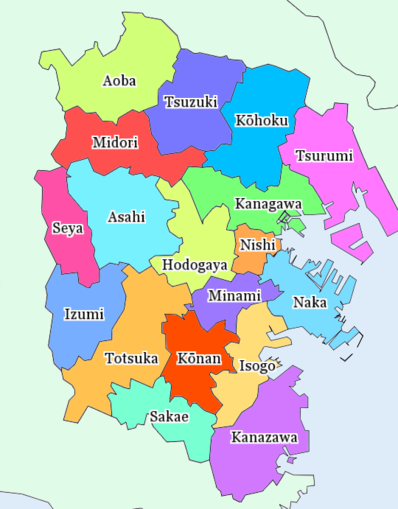 |
| 2 | Asahi-ku | 旭区 | 249,045 | 32.77 | 7,600 | |
| 3 | Hodogaya-ku |
保土ヶ谷区 | 205,887 | 21.81 | 9,400 | |
| 4 | Isogo-ku | 磯子区 | 163,406 | 19.17 | 8,520 | |
| 5 | Izumi-ku | 泉区 | 155,674 | 23.51 | 6,620 | |
| 6 | Kanagawa-ku | 神奈川区 | 230,401 | 23.88 | 9,650 | |
| 7 | Kanazawa-ku | 金沢区 | 209,565 | 31.01 | 6,760 | |
| 8 | Kōhoku-ku | 港北区 | 332,488 | 31.40 | 10,588 | |
| 9 | Kōnan-ku | 港南区 | 221,536 | 19.87 | 11,500 | |
| 10 | Midori-ku | 緑区 | 176,038 | 25.42 | 6,900 | |
| 11 | Minami-ku | 南区 | 197,019 | 12.67 | 15,500 | |
| 12 | Naka-ku (administrative center) | 中区 | 146,563 | 20.86 | 7,030 | |
| 13 | Nishi-ku | 西区 | 93,210 | 7.04 | 13,210 | |
| 14 | Sakae-ku | 栄区 | 124,845 | 18.55 | 6,750 | |
| 15 | Seya-ku | 瀬谷区 | 126,839 | 17.11 | 7,390 | |
| 16 | Totsuka-ku | 戸塚区 | 274,783 | 35.70 | 7,697 | |
| 17 | Tsurumi-ku | 鶴見区 | 270,433 | 33.23 | 8,140 | |
| 18 | Tsuzuki-ku | 都筑区 | 211,455 | 27.93 | 7,535 | |
Government and politics[]
The Yokohama City Council consists of 86 members elected from a total of 18 Wards. The LDP has minority control with 36 seats. The mayor is Fumiko Hayashi, who succeeded Hiroshi Nakada in September 2009.
List of mayors (from 1889)[]
|
|
|
Culture and sights[]
Yokohama's cultural and tourist sights include:
- Yokohama Chinatown
- Yamashita Park (at the harbor)
- Harbor View Park
- The Hikawa Maru, historic passenger and cargo ship
- Yokohama Marine Tower
- Yokohama Triennale
- Minato Mirai 21
- Landmark Tower, 296 m high, second tallest skyscraper in Japan
- Nippon Maru, Museum ship
- Yokohama Stadium (the Yokohama DeNA BayStars Pro baseball teams's home field)
- Yokohama Foreign Cemetery
- Sankei-en Garden
- Kishine-Park
- Kanazawa Bunko, preserves the cultural heritage of the Hōjō clan
- Zō-no-Hana Terrace (象の鼻テラス)[21]
- Gumyōji, oldest temple in the city
Museums[]
There are 42 museums in the city area.[22]
- Silk Museum: production and processing of silk; with lots of clothes.
- Yokohama Archives of History: On the development of the port and city, especially the arrival of Perry.
- CupNoodles Museum (Momofuku Andō Instant Ramen Museum): The interactive museum deals with the invention of the Japanese instant noodle soup on several floors. In one department, original soup kitchens from eight countries are set up, where you can try the culture-specific noodle soups. The museum is located near Shin-Yokohama Station.
- Matsuri Museum: This museum is dedicated to the shrine festivals (Japanese Matsuri) taking place in Yokohama.
Gallery[]

Sankei-en Garden

Yokohama Chinatown

CupNoodles Museum

Hikawa Maru

Yokohama Red Brick Warehouse
Yokohama World Porters

Mitsui Outlet Park Yokohama Bayside

Yokohama Municipal Kanazawa Zoo

Yokohama Hakkeijima Sea Paradise

Yokohama Station
Yokohama Foreign General Cemetery

Iseyama Kotai Shrine
Excursion destinations[]
In 2016, 46,017,157 tourists visited the city, 13.1% of whom were overnight guests.[22]
- Kodomo no kuni: Means "Children's country". A nice destination to spend an eventful day with the family. Lots of space for walking and playing. There is also a petting zoo.
- Nogeyama Zoo: One of the few zoos that do not charge admission. It has a large number of animals and a petting zoo where children can play with small animals.
- Zoorasia: Nice zoo with lots of play options for children. However, this zoo costs admission.
- Yokohama Hakkeijima Sea Paradise: A large park with an aquarium. Otherwise rides, shops, restaurants, etc.
- Since 2020, after six years of development, a giant robot named Gundam, which is 18 meters high and weighs 25 tons, has been watching over the port area as a tourist attraction. The giant robot, in which there is a cockpit and whose hands are each two meters long, is based as a figure on a science fiction television series, can move and sink to its knees.[23] The giant robot was manufactured by the company "Gundam Factory Yokohama" under Managing Director Shin Sasaki.
- Kamonyama Park
In popular media[]
- Yukio Mishima's novel The Sailor Who Fell from Grace with the Sea is set mainly in Yokohama. Mishima describes the city's port and its houses, and the Western influences that shaped them.
- From Up on Poppy Hill is a 2011 Studio Ghibli animated drama film directed by Gorō Miyazaki set in the Yamate district of Yokohama. The film is based on the serialized Japanese comic book of the same name.
- The main setting of James Clavell's book Gai-Jin is in historical Yokohama.
- Vermillion City in the Kanto region from the Pokémon franchise is based on Yokohama.
- One of the Pretty Cure crossover movies takes place in Yokohama. In the fourth movie of the series, Pretty Cure All Stars New Stage: Friends of the Future, the Pretty Cure appear standing on top of the Cosmo Clock 21 in Minato Mirai.
- The main setting of the Japanese visual novel series Muv-Luv, first a school and then, in an alternate history, a military base is built in Yokohama with the objective of carrying out the Alternative IV Plan meant to save humanity.
- In Command & Conquer: Red Alert 3, Yokohama is under siege by the Soviet Union and Allied Nations to stop the Empire of The Rising Sun. The player must defend Yokohama and then lead a counterattack as the Empire.
- The manga Bungo Stray Dogs is set in Yokohama.
- The Japanese mixed-media project, Hamatora takes place in Yokohama.
- The final battle in Godzilla, Mothra and King Ghidorah: Giant Monsters All-Out Attack takes place in Yokohama.
- In My Hero Academia, it is the location of the Nomu Warehouse where they created artificial Humans (a.k.a. Nomus).
- Sumaru City in Persona 2: Innocent Sin and Persona 2: Eternal Punishment is based on Yokohama.
- Miyabi City in The Caligula Effect is based on Yokohama, including depictions of landmarks such as an unfinished Landmark Tower and Yokohama Hakkeijima Sea Paradise (referred to in game as Sea Paraiso).
- The video game Yakuza: Like a Dragon is set in Isezaki Ijincho, a fictional district in Yokohama based on Isezakichō.
- Yokohama is also represented in the multimedial project by King Records, Hypnosis Mic: Division Rap Battle
- Yokohama is the setting of the anime After the Rain as well as manga series with the same title by Jun Mayuzuki.
Sports[]
- Soccer: Yokohama F. Marinos (J.League Division 1), Yokohama FC (J.League Division 1), YSCC Yokohama (J.League Division 3), NHK Yokohama FC Seagulls (Nadeshiko League Div.2)
- Baseball: Yokohama DeNA BayStars
- Velodrome: Kagetsu-en Velodrome
- Basketball: Yokohama B-Corsairs
- Tennis: Ai Sugiyama
- American football: Yokohama Harbors
Economy and infrastructure[]
This section needs expansion. You can help by . (June 2008) |
The city has a strong economic base, especially in the shipping, biotechnology, and semiconductor industries. Nissan moved its headquarters to Yokohama from Chūō, Tokyo in 2010.[24] Yokohama's GDP per capita (Nominal) was $30,625($1=\120.13).[25][26]
Transport[]

Yokohama is serviced by the Tōkaidō Shinkansen, a high-speed rail line with a stop at Shin-Yokohama Station. Yokohama Station is also a major station, with two million passengers daily. The Yokohama Municipal Subway, Minatomirai Line and Kanazawa Seaside Line provide metro services.
Maritime transport[]
Yokohama is the world's 31st largest seaport in terms of total cargo volume, at 121,326 freight tons as of 2011, and is ranked 37th in terms of TEUs (Twenty-foot equivalent units).[27]
In 2013, APM Terminals Yokohama facility was recognised as the most productive container terminal in the world averaging 163 crane moves per hour, per ship between the vessel's arrival and departure at the berth.[28]
Rail transport[]
Railway stations[]
- ■ East Japan Railway Company
- ■ Tōkaidō Main Line
- – Yokohama – Totsuka –
- ■ Yokosuka Line
- – Yokohama – Hodogaya – Higashi-Totsuka – Totsuka –
- ■ Keihin-Tōhoku Line
- – Tsurumi – Shin-Koyasu – Higashi-Kanagawa – Yokohama
- ■ Negishi Line
- Yokohama – Sakuragichō – Kannai – Ishikawachō – Yamate – Negishi – Isogo – Shin-Sugita – Yōkōdai – Kōnandai – Hongōdai –
- ■ Yokohama Line
- ■ Nambu Line
- – Yakō –
- ■ Tsurumi Line
- Main Line : Tsurumi – Kokudō – Tsurumi-Ono – Bentembashi – Asano – Anzen –
- Umi-Shibaura Branch : Asano – Shin-Shibaura – Umi-Shibaura
- ■ Central Japan Railway Company
- ■ Tōkaidō Shinkansen
- – Shin-Yokohama –
- ■ Keikyu
- ■ Keikyu Main Line
- – Tsurumi-Ichiba – Keikyū Tsurumi – Kagetsuen-mae – Namamugi – Keikyū Shin-Koyasu – Koyasu – Kanagawa-Shinmachi – Naka-Kido – Kanagawa – Yokohama – Tobe – Hinodechō – Koganechō – Minami-Ōta – Idogaya – Gumyōji – Kami-Ōoka – Byōbugaura – Sugita – Keikyū Tomioka – Nōkendai – Kanazawa-Bunko – Kanazawa-Hakkei –
- ■ Keikyu Zushi Line
- Kanazawa-Hakkei – Mutsuura –
- ■ Tokyu Corporation
- ■ Tōyoko Line
- – Hiyoshi – Tsunashima – Ōkurayama – Kikuna – Myōrenji – Hakuraku – Higashi-Hakuraku – Tammachi – Yokohama
- ■ Meguro Line
- – Hiyoshi
- ■ Den-en-toshi Line
- ■ Kodomonokuni Line
- Nagatsuta – Onda – Kodomonokuni
- ■ Sagami Railway
- ■ Sagami Railway Main Line
- Yokohama – Hiranumabashi – Nishi-Yokohama – Tennōchō – Hoshikawa – Wadamachi – Kamihoshikawa – Nishiya – Tsurugamine – Futamatagawa – Kibōgaoka – Mitsukyō – Seya –
- ■ Izumino Line
- Futamatagawa – Minami-Makigahara – Ryokuentoshi – Yayoidai – Izumino – Izumi-chūō – Yumegaoka
- ■ Yokohama Minatomirai Railway
- ■ Minatomirai Line
- Yokohama – Shin-Takashima – Minato Mirai – Bashamichi – Nihon-ōdōri – Motomachi-Chūkagai
- ■ Yokohama City Transportation Bureau
- ■ Blue Line
- – Shimoiida – Tateba – Nakada – Odoriba – Totsuka – Maioka – Shimonagaya – Kaminagaya – Kōnan-Chūō – Kami-Ōoka – Gumyōji – Maita – Yoshinochō – Bandōbashi – Isezakichōjamachi – Kannai – Sakuragichō – Takashimachō – Yokohama – Mitsuzawa-shimochō – Mitsuzawa-kamichō – Katakurachō – Kishine-kōen – Shin-Yokohama – Kita Shin-Yokohama – Nippa – Nakamachidai – Center Minami – Center Kita – Nakagawa – Azamino
- ■ Green Line
- Nakayama – Kawawachō – Tsuzuki-Fureai-no-Oka – Center Minami – Center Kita – Kita-Yamata – Higashi-Yamata – Takata – Hiyoshi-Honchō – Hiyoshi
- ■ Yokohama New Transit
- ■ Kanazawa Seaside Line
- Shin-Sugita – Nambu-Shijō – Torihama – Namiki-Kita – Namiki-Chūō – Sachiura – Sangyō-Shinkō-Center – Fukuura – Shidai-Igakubu – Hakkeijima – Uminokōen-Shibaguchi – Uminokōen-Minamiguchi – Nojimakōen – Kanazawa-Hakkei
Education[]
Public elementary and middle schools are operated by the city of Yokohama. There are nine public high schools which are operated by the Yokohama City Board of Education,[29] and a number of public high schools which are operated by the Kanagawa Prefectural Board of Education. Yokohama National University is a leading university in Yokohama which is also one of the highest ranking national universities in Japan.
- 46,388 children attend the 260 kindergartens.
- Almost 386,000 students are taught in 351 primary schools.
- There are 16 universities including Yokohama National University. The number of students is around 83,000.
- 19 public libraries had 9.5 million loans in 2016.[22]
International relations[]

Twin towns – sister cities[]
Yokohama is twinned with:[30]
 Constanța, Romania (since October 1977)
Constanța, Romania (since October 1977) Lyon, France (since April 1959)
Lyon, France (since April 1959) Manila, Philippines (since July 1965)
Manila, Philippines (since July 1965) Mumbai, India (since June 1965)
Mumbai, India (since June 1965) Odessa, Ukraine (since July 1965)
Odessa, Ukraine (since July 1965) San Diego, United States (since October 1957)
San Diego, United States (since October 1957) Shanghai, China (since November 1973)
Shanghai, China (since November 1973) Vancouver, Canada (since July 1965)
Vancouver, Canada (since July 1965)
Partner cities[]
 Abidjan, Ivory Coast
Abidjan, Ivory Coast Beijing, China (2006)
Beijing, China (2006) Busan, South Korea (2006)
Busan, South Korea (2006) Frankfurt, Germany (2011)
Frankfurt, Germany (2011) Hanoi, Vietnam (2007)
Hanoi, Vietnam (2007) Ho Chi Minh City, Vietnam (2007)
Ho Chi Minh City, Vietnam (2007) Incheon, South Korea (2009)
Incheon, South Korea (2009) Seberang Perai, Malaysia (2016)[31]
Seberang Perai, Malaysia (2016)[31] Taipei, Taiwan (2006)
Taipei, Taiwan (2006) Tel Aviv, Israel (2012)
Tel Aviv, Israel (2012) Tianjin, China (2008)
Tianjin, China (2008)
Noted People[]
Hiroshi Abe Model
Takehito Koyasu Singer & Seiyū
Toru Furuya Singer & Seiyū
References[]
Citations[]
- ^ https://en.oxforddictionaries.com/definition/yokohama
- ^ "Memories of old Honmoku". The Japan Times. May 19, 1999. Retrieved March 3, 2021.
- ^ "Yokohama City History, pg. 3" (PDF).
- ^ Der Große Brockhaus. 16. edition. Vol. 6. F. A. Brockhaus, Wiesbaden 1955, p. 82
- ^ "Official Yokohama city website it is fresh". City.yokohama.jp. Archived from the original on June 12, 2010. Retrieved May 5, 2010.
- ^ Arita, Erika, "Happy Birthday Yokohama!", The Japan Times, May 24, 2009, p. 7.
- ^ Fukue, Natsuko, "Chinese immigrants played vital role", Japan Times, May 28, 2009, p. 3.
- ^ Matsutani, Minoru, "Yokohama – city on the cutting edge", Japan Times, May 29, 2009, p. 3.
- ^ Galbraith, Michael (June 16, 2013). "Death threats sparked Japan's first cricket game". Japan Times. Retrieved April 1, 2016.
- ^ Jump up to: a b "Interesting Tidbits of Yokohama". Yokohama Convention & Visitors Bureau. Archived from the original on July 17, 2020. Retrieved February 7, 2009.
- ^ Hammer, Joshua. (2006). Yokohama Burning: The Deadly 1923 Earthquake and Fire that Helped Forge the Path to World War II, p. 143.
- ^ Hammer, pp. 149-170.
- ^ "Tsurumi River Multipurpose Retarding Basin". www.japanriver.or.jp. Retrieved January 9, 2016.
- ^ "Collection of 1923 Japan earthquake massacre testimonies released". www.hani.co.kr. September 3, 2013. Retrieved January 8, 2016.
- ^ "FNN Remembering 3/11: Yokohama station and surrounding areas at time of earthquake occurrence". www.fnn-news.com. Retrieved January 10, 2016.
- ^ "Yokohama, Japan Köppen Climate Classification (Weatherbase)". Weatherbase. Retrieved July 9, 2019.
- ^ "Yokohama Weather, When to Go and Yokohama Climate Information". world-guides.com. Retrieved January 11, 2010.
- ^ 気象庁 / 平年値(年・月ごとの値). Japan Meteorological Agency. Retrieved May 19, 2021.
- ^ Japanese Imperial Commission (1878). Le Japon à l'exposition universelle de 1878. Géographie et histoire du Japon (in French).
- ^ 横浜市区別外国人登録人口(平成30年3月末現在). Retrieved April 13, 2018.
- ^ Webseite des Kulturzentrums
- ^ Jump up to: a b c "Statistical Booklet Book of Yokohama 2018" (PDF). www.city.yokohama.lg.jp. Archived from the original (PDF) on October 16, 2018. Retrieved November 2, 2020.
- ^ Tagesthemen. Beitrag in der Nachrichtensendung der ARD, Moderation: Ingo Zamperoni, 30. November 2020, 35 Min. Eine Produktion von Das Erste
- ^ "Nissan To Create New Global and Domestic Headquarters in Yokohama City by 2010". Japancorp.net. Retrieved May 6, 2009.
- ^ "Yokohama GDP 2015".
- ^ "Yokohama 2015 population" (PDF).
- ^ "Ports & World Trade". www.aapa-ports.org.
- ^ "Chinese Ports Lead the World in Berth Productivity, JOC Group Inc. Data Shows". Press Release. AXIO Data Group. JOC Inc. June 24, 2014. Retrieved March 20, 2015.
- ^ "Official Yokohama city website". City.yokohama.jp. Archived from the original on June 19, 2010. Retrieved May 5, 2010.
- ^ "Yokohama's Sister/Friendship Cities". city.yokohama.lg.jp. Yokohama. Retrieved February 25, 2021.
- ^ "MPSP sets sights on city status". The Star. August 1, 2016.
Sources[]
- Hammer, Joshua (2006). Yokohama Burning: The Deadly 1923 Earthquake and Fire that Helped Forge the Path to World War II. New York: Simon & Schuster. ISBN 978-0-7432-6465-5 (cloth).
- Heilbrun, Jacob. "Aftershocks". The New York Times, September 17, 2006.
External links[]
| Wikimedia Commons has media related to Yokohama. |
- Official Website (in Japanese)
- Yokohama Tourism Website (in English)
 Geographic data related to Yokohama at OpenStreetMap
Geographic data related to Yokohama at OpenStreetMap
- Yokohama
- Environmental model cities
- Populated coastal places in Japan
- Port settlements in Japan
- Cities in Kanagawa Prefecture
- Cities designated by government ordinance of Japan
